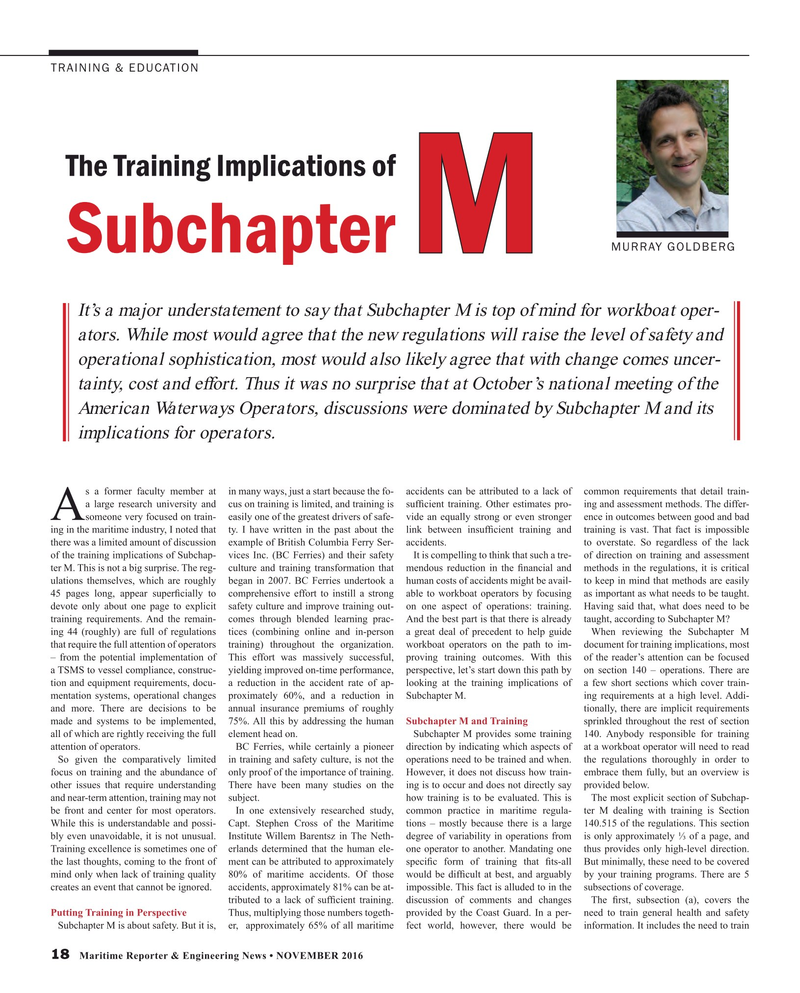
Page 18: of Maritime Reporter Magazine (November 2016)
Workboat Edition
Read this page in Pdf, Flash or Html5 edition of November 2016 Maritime Reporter Magazine
TRAINING & EDUCATION
The Training Implications of
MURRAY GOLDBERG
Subchapter M
It’s a major understatement to say that Subchapter M is top of mind for workboat oper- ators. While most would agree that the new regulations will raise the level of safety and operational sophistication, most would also likely agree that with change comes uncer- tainty, cost and effort. Thus it was no surprise that at October’s national meeting of the
American Waterways Operators, discussions were dominated by Subchapter M and its implications for operators.
s a former faculty member at in many ways, just a start because the fo- accidents can be attributed to a lack of common requirements that detail train- a large research university and cus on training is limited, and training is suf? cient training. Other estimates pro- ing and assessment methods. The differ- someone very focused on train- easily one of the greatest drivers of safe- vide an equally strong or even stronger ence in outcomes between good and bad
A ing in the maritime industry, I noted that ty. I have written in the past about the link between insuf? cient training and training is vast. That fact is impossible there was a limited amount of discussion example of British Columbia Ferry Ser- accidents. to overstate. So regardless of the lack of the training implications of Subchap- vices Inc. (BC Ferries) and their safety It is compelling to think that such a tre- of direction on training and assessment ter M. This is not a big surprise. The reg- culture and training transformation that mendous reduction in the ? nancial and methods in the regulations, it is critical ulations themselves, which are roughly began in 2007. BC Ferries undertook a human costs of accidents might be avail- to keep in mind that methods are easily 45 pages long, appear super? cially to comprehensive effort to instill a strong able to workboat operators by focusing as important as what needs to be taught. devote only about one page to explicit safety culture and improve training out- on one aspect of operations: training. Having said that, what does need to be training requirements. And the remain- comes through blended learning prac- And the best part is that there is already taught, according to Subchapter M?
ing 44 (roughly) are full of regulations tices (combining online and in-person a great deal of precedent to help guide When reviewing the Subchapter M that require the full attention of operators training) throughout the organization. workboat operators on the path to im- document for training implications, most – from the potential implementation of This effort was massively successful, proving training outcomes. With this of the reader’s attention can be focused a TSMS to vessel compliance, construc- yielding improved on-time performance, perspective, let’s start down this path by on section 140 – operations. There are tion and equipment requirements, docu- a reduction in the accident rate of ap- looking at the training implications of a few short sections which cover train- mentation systems, operational changes proximately 60%, and a reduction in Subchapter M. ing requirements at a high level. Addi- and more. There are decisions to be annual insurance premiums of roughly tionally, there are implicit requirements made and systems to be implemented, 75%. All this by addressing the human Subchapter M and Training sprinkled throughout the rest of section all of which are rightly receiving the full element head on. Subchapter M provides some training 140. Anybody responsible for training attention of operators. BC Ferries, while certainly a pioneer direction by indicating which aspects of at a workboat operator will need to read
So given the comparatively limited in training and safety culture, is not the operations need to be trained and when. the regulations thoroughly in order to focus on training and the abundance of only proof of the importance of training. However, it does not discuss how train- embrace them fully, but an overview is other issues that require understanding There have been many studies on the ing is to occur and does not directly say provided below.
and near-term attention, training may not subject. how training is to be evaluated. This is The most explicit section of Subchap- be front and center for most operators. In one extensively researched study, common practice in maritime regula- ter M dealing with training is Section
While this is understandable and possi- Capt. Stephen Cross of the Maritime tions – mostly because there is a large 140.515 of the regulations. This section bly even unavoidable, it is not unusual. Institute Willem Barentsz in The Neth- degree of variability in operations from is only approximately ? of a page, and
Training excellence is sometimes one of erlands determined that the human ele- one operator to another. Mandating one thus provides only high-level direction. the last thoughts, coming to the front of ment can be attributed to approximately speci? c form of training that ? ts-all But minimally, these need to be covered mind only when lack of training quality 80% of maritime accidents. Of those would be dif? cult at best, and arguably by your training programs. There are 5 creates an event that cannot be ignored. accidents, approximately 81% can be at- impossible. This fact is alluded to in the subsections of coverage.
tributed to a lack of suf? cient training. discussion of comments and changes The ? rst, subsection (a), covers the
Putting Training in Perspective Thus, multiplying those numbers togeth- provided by the Coast Guard. In a per- need to train general health and safety
Subchapter M is about safety. But it is, er, approximately 65% of all maritime fect world, however, there would be information. It includes the need to train 18 Maritime Reporter & Engineering News • NOVEMBER 2016
MR #11 (18-25).indd 18 11/4/2016 2:19:57 PM

 17
17

 19
19
